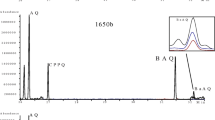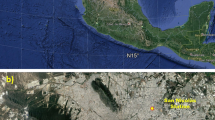Abstract
A method has been developed for analysis of the highly potent polycyclic aromatic hydrocarbon (PAH) carcinogens dibenzo(a,l)pyrene, dibenzo(a,h)pyrene, and dibenzo(a,i)pyrene (molecular weight 302) present in small amounts in diesel and air particulate material. The method can also be used for analysis of the PAH benzo(a)pyrene, coronene, and perylene, for which reference and certified values are available for the standard reference materials used for validation of the method—SRM 1649a (urban dust) and SRM 2975 (diesel particulate matter). The only NIST values that have been published for these dibenzopyrene isomers in the analyzed SRM are reference values for dibenzo(a,i)pyrene and dibenzo(a,h)pyrene in SRM 1649a. The concentrations determined in the SRM were in good agreement with reported NIST-certified and reference values and other concentrations reported in the literature. Standard reference material 1650 (diesel particulate matter) was also analyzed. The method could not, however, be validated using this material because certification of SRM 1650 had expired. The method is based on ultrasonically assisted extraction of the particulate material, then silica SPE pre-separation and isolation, and, separation and detection by hyphenated LC–GC–MS. The method is relatively rapid and requires only approximately 1–5 mg SRM particulate material to identify and quantify the analytes. Low extraction recoveries for the analytes, in particular the dibenzopyrenes, when extracting diesel SRM 2975 and 1650 resulted, however, in the dibenzopyrenes being present in amounts near their limits of quantifications in these samples. The method’s limit of quantification (LOQ), based on analyses of SRM 1649a, is in the range 10–77 pg. By use of this method more than 25 potential PAH isomers with a molecular weight of 302 could be separated.





Similar content being viewed by others
References
Boström C–E, Gerde P, Hanberg A, Jernström B, Johansson C, Kyrklund T, Rannug A, Törnqvist M, Victorin K, Westerholm R (2002) Environ Health Perspect Supplements 110:451–488
Ambient Air Pollution by Polycyclic Aromatic Hydrocarbons (PAH). Position paper (2001) Luxembourg: Office for Official Publications of the European Communities ISBN 92–894–2057–X
Cook J, Hewett C, Hieger I (1933) J Chem Soc 395–405
IARC (1983) Polynuclear aromatic compounds. Part 1. Chemicals, environmental and experimental data, International agency for research on cancer (IARC), Lyon, France
IARC (1989) Monographs on the evaluation of carcinogenic risks of chemicals to humans: Diesel and gasoline engine exhausts and some nitro-PAH. International agency for research on cancer (IARC), Lyon, France
Cavalieri E, Higginbotham S, RamaKrishna N, Devanesan P, Todorovic R, Rogan E, Salmasi S (1991) Carcinogenesis 12:1939–1944
CARB (1994) Benzo[a]pyrene as a Toxic Contaminant; Part B Health Assessment. Berkeley, CA: California Environmental Protection Agency, Air Resources Board.
Collins J, Brown S, Marty M (1991) Regul Toxicol Pharmacol 13:170–184
Muller P (1997) Scientific Criteria Document for Multimedia Standards Development Polycyclic Aromatic Hydrocarbons (PAH); Part 1: Hazard Identification and Dose-Response Assessment. Ontario, CN: Standard Development Branch, Ontario Ministry of Environment and Energy
Binkova B, Sram R (2004) Mutat Res 547:109–121
Polycyclic Aromatic Hydrocarbons: 15 Listings. U.S. Department of Health and Human Services, Ninth Report on Carcinogens, 2001; http://ehp.niehs.nih.gov/roc/ninth/rahc/pahs.pdf.
Platt K, Dienes H, Tommasone M, Luch A Chem-Biol Interact (2004) 148:27–36
Sander L, Wise S Polycyclic Aromatic Hydrocarbon Structure Index, National Institute of Standards and Technology (NIST) Special Publication 922; http://ois.nist.gov/pah/
Kozin S, Gooijer C, Velthorst N (1995) Anal Chem 67:1623–1626.
Kozin S, Gooijer C, Velthorst N, Harmsren J, Wieggers R (1995) Int J Environ Anal Chem 61:285–297
Pace C, Betowski L (1995) J Am Soc Mass Spectrom 6:597–607
Kozin I, Gooijer C, Velthorst N, Hellou J, Zitko V (1996) Chemosphere 33:1435–1447
Schubert P, Schantz M, Sander L, Wise S (2003) Anal Chem 75:234–246
Wise S, Deissler A, Sander L (1993) Polycyclic Aromat Compd 3:169–184
Sauvain J, Vu Duc T, Huynh C (2001) Fresenius J Anal Chem 371:966–974
Seidel A, Frank H, Behnke A, Schneider D, Jacob J (2004) Polycyclic Aromat Compd 24:759–771
Sauvain J, Vu Duc T, Guillemin M (2003) Int Arch Occup Environ Health 76:443–455
Sauvain J, Vu Duc T (2004) J Sep Sci 27:78–88
Durant J, Lafleur A, Plummer E, Taghizadeh K, Busby W, Thilly W (1998) Environ Sci Technol 32:1894–1906
Mininni G, Sbrilli A, Guerriero E, Rotatori M (2004) Water, Air, Soil Pollut 154:3–18
Yu S, Campiglia A (2005) Anal Chem 77:1440–1447
Christensen A, Östman C, Westerholm R (2005) Anal Bioanal Chem 381:1206–1216
SRM 1649a. Urban Dust. Certificate of Analysis, National Institute of Standards and Technology (2001) Gaithersburg, USA
Turrio–Baldassarri L, Battistelli C, Iamiceli A (2003) Anal Bioanal Chem 375:589–595
Schantz M, Nichols J, Wise S (1997) Anal Chem 69:4210–4219
Pineiro–Iglesias M, Lopez–Mahia P, Vazquez–Blanco E, Muniategui–Lorenzo S, Prada–Rodriguez D (2002) Polycyclic Aromat Compd 22:129–146
SRM 1650a. Diesel Particulate Matter. Certificate of Analysis, National Institute of Standards and Technology (2000) Gaithersburg, USA
SRM 1650. Diesel Particulate Matter. Certificate of Analysis, National Institute of Standards and Technology (1991) Gaithersburg, USA
SRM 2975. Diesel Particulate Matter (Industrial Forklift). Certificate of Analysis, National Institute of Standards and Technology (2000) Gaithersburg, USA
Acknowledgements
The authors gratefully acknowledge Anders Christensen for help and advice and Lena Elfver for skilful laboratory assistance. This study was financed by the Swedish Emission Research Programme (Emissionsforskningsprogrammet, EMFO).
Author information
Authors and Affiliations
Corresponding author
Rights and permissions
About this article
Cite this article
Bergvall, C., Westerholm, R. Determination of dibenzopyrenes in standard reference materials (SRM) 1649a, 1650, and 2975 using ultrasonically assisted extraction and LC–GC–MS. Anal Bioanal Chem 384, 438–447 (2006). https://doi.org/10.1007/s00216-005-0192-5
Received:
Revised:
Accepted:
Published:
Issue Date:
DOI: https://doi.org/10.1007/s00216-005-0192-5




